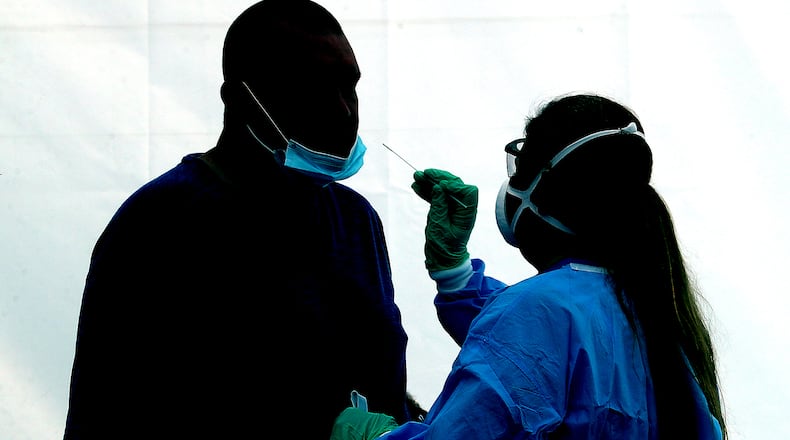“It’s been hard,” Clark County Combined Health District Commissioner Charles Patterson said. “It’s pretty devastating. This isn’t a joke. This is life and death.”
Many businesses directed their employees to start working from home in mid-March, with some yet to return to the office. Schools were also shuttered as students finished out the academic year from home.
Both the City of Springfield and Clark County closed government building, held meetings via Zoom conferences, furloughed employees and cut their budgets to adjust to collecting less in sales tax revenue.
Restaurants and bars were forced to provide carry-out only and reduce their capacities by removing sections of tables or installing plexiglass barries between booths. Entertainment events and sports were canceled, some of which haven’t been given a return date.
Social distancing and wearing face masks have become the new normal after Gov. Mike DeWine made face coverings in public mandatory on July 23 to help reduce the spread of the coronavirus.
Over the course of the last six months in Clark County has seen 1,579 total cases of the virus and 35 total deaths, 33 confirmed and two probable, as of Friday, according to the Ohio Department of Health. In Champaign County, 268 have tested positive and three have died.
Of the 33 confirmed deaths, 18 have occurred in less than a month. That’s because the county has been slightly behind the pandemic curve, Patterson said. Meaning trends like outbreaks in long-term care facilities and advancements in testing have occurred more recently in the county as opposed to earlier like larger cities like Dayton.
The county began seeing the spread of the virus in several outbreaks at workplaces, the largest being at the Dole Fresh Vegetables plant in Springfield.
The outbreak ripped through the plant in early June, requiring mass testing of all 829 employees. In total, the plant recorded 282 positive cases linked to the plant before being contained in late June.
The massive outbreak caused the county to experience its first major jump in cases.
The same can be said about Champaign County, which saw their first bump in cases in early August after an outbreak at Michael Farms in Urbana. The outbreak led to 50 positive cases, all in employees.
In Clark County, the Dole outbreak resulted in the CCCHD partnering with the city of Springfield to host three free pop-up COVID-19 testing clinics throughout the county over the course of July.
At the clinics, 2,278 people were tested with 59.7% being Clark County residents and 2.7% testing positive, according to data from the CCCHD.
Credit: Bill Lackey
Credit: Bill Lackey
Throughout the pandemic, as soon as the county has managed to “put out a fire,” Patterson said, another seems to arise.
Cases began to climb again in early August with the spread of the virus into long-term care facilities in Clark County. On Aug. 12, the county recorded 10 long-term care facilities, out of 13, with at least one current resident or staff member with a confirmed case of COVID-19.
The largest long-term care facility outbreak was at Mercy Health Oakwood Village, which on Aug. 29, reported 52 cumulative resident and staff cases and nine resident deaths.
Just as the number of long-term care facilities with at least one COVID-19 cut in half within the last month, another “fire” erupted.
The district has now turned its attention to Wittenberg University in Springfield, which has seen an explosion in cases within the last week, Patterson said. On Aug. 31, the university reported one active case. On Friday, they reported 86, according to their website.
“That’s the thing that is pushing our numbers up now,” Patterson said.
As the pandemic stretches into the second half of the year, Patterson said it’s hard to see the light at the end of the tunnel and the return to “normal life.”
“Long term, we have been slowing down. But we’ve been here before, so it’s really hard to tell what’s next," Patterson said.
Here is a look back at how the coronavirus pandemic has effected three aspects of Clark County life – schools, businesses and the arts, over the last six months.
Credit: Bill Lackey
Credit: Bill Lackey
School:
Schools across the state, including in Clark and Champaign Counties, closed on March 16 after DeWine ordered the closure of all public and private K-12 schools to help slow the spread of the coronavirus.
High school seniors felt the impact immediately with most traditional activities being canceled, but districts worked to provide a graduation experience.
Most districts held socially distanced graduation ceremonies while others held individual ceremonies, but almost all districts recorded them and put those ceremonies together for a virtual graduation video.
Districts were able to reopen for the 2020-21 academic year with guidelines and safety protocols put in place, resulting in schools utilizing in-person, online or hybrid learning.
The first local school district to reopen was Triad on Aug. 20, with Clark-Shawnee being the last district to open on Sept. 10.
All districts in Clark and Champaign Counties have protocols in place designed to help keep students and staff healthy and safe, including wearing face coverings, social distancing when around others, and practicing good hygiene such as frequent hand washing.
“As a district, our team has worked hard to adapt to the best of our abilities to the constantly evolving challenges COVID-19 presents. From the beginning, we’ve put our focus on the well-being of our students, staff and families, along with supporting our students,” Northeastern Local Schools Superintendent John Kronour said. “It’s hard to guess where COVID-19 will take us in the future, but we’re prepared to continue evolving and adapting to the circumstances ahead.”
Beginning later this months, all districts in the state will be are required to report any positive COVID-19 cases in students or staff to their local health departments. The state will report those numbers weekly.
Two school districts in Clark County have reported either a case or suspected case of COVID-19 this school year.
The first positive case was found in Rolling Hills Elementary School in the Northeastern district on Sept. 2, and the person who tested positive is a staff member.
A suspected case was found at Enon Primary School in the Greenon District on Sept. 3, but this case has not yet been confirmed positive.
A Tecumseh employee also tested positive at the end of July and another was quarantined.
Greenon’s superintendent said the district continues to rise to the challenges that COVID-19 presents.
“The last few months haven’t been easy, but with a lot of teamwork, kindness, and a focus on keeping our students and staff healthy and safe, we’ve all worked together to make the best of our circumstances,” Superintendent Darrin Knapke said. “It’s impossible to predict what’s ahead, but we’re grateful to have a top-notch staff, caring students and families, and a supportive community behind us as we continue to navigate through the challenges.”
Credit: Bill Lackey
Credit: Bill Lackey
Business:
The coronavirus pandemic and statewide preventative measures designed to curb its spread had an immediate economic impact in the area starting in March.
By April, the unemployment rate had shot up to 17.4% from the 5.3% reported in the previous month.
The state and the nation also saw record-breaking numbers of new unemployment claims filed at the end of March, mirroring state and national trends, as companies had to temporarily shutter their doors or lay off employeesfollowing a statewide order in March that called for the closing of businesses that were deemed nonessential.
Ohio saw a total of 468,414 of those claims made during the last two weeks of March.
In Clark County, there was a 2,746% jump in jobless claims between the week ending March 14 and the week ending March 21. During that time, the number of local filings went from 70 to 1,992.
The pandemic also interrupted supply chains for some local manufacturers that stayed open throughout the pandemic. Other business saw an increase in the demand for their services.
The state also called for the suspension of elective procedures for hospitals in an effort to preserve personal protective equipment.
That led to the Ohio Valley Surgical Hospital in Springfield to temporarily close as a large part of its operation was those types of procedures.
However, the hospital began to ramp up its operation in May as the state began to allow some of those procedures to resume. In June, Ohio Valley reported scheduling about 80% of the average amount of surgeries it conducts in a month period.
Some businesses that were deemed essential such as restaurants had to adjust their operations, allowing only for delivery or carryout services. However, some of those business owners decided to temporarily shutter their doors as most of their profits came from in-person dining.
The number of jobs available in the county went down as well and that drop represented the single largest one-month job decrease observed in decades in the county.
The number of people listed as working in the county in April was 43,800 people. That was a drop of 6,100 when compared to March. That month reported a workforce of 49,900 people, according to the U.S. Bureau of Labor Statistics.
Data released from the Bureau of Labor Statistics showed that Clark County lost 5,900 jobs in April and has since added back less than 41% of those jobs.
In terms of traveling to and staying overnight in the county, local occupancy rates for lodging such as hotels also dropped between March and April, going from 43.3% to 32.3%, according to data provided by the Greater Springfield Convention and Visitors Bureau.
In addition, those months saw large decreases in the average occupancy rates when compared to the same period last year. For March, that number was down by 33.1%. In April, it dropped by 53% when compared to the same time in 2019.
However, the monthly occupancy rates have gone back up since May and in July that number was reported to be just a little under 53%. However, there has been in total a 31.7% drop in those occupancy rates for 2020 when compared to 2019.
Some business travel, which makes up a large portion of weekday hotel stays in the county, has since resumed, after a number of companies put a hold on travel during the beginning of the pandemic.
Big local tourism drivers, such as the Clark County fairgrounds, have also started to resume holding special events. In recent months, there has also been an increase in local marketing efforts emphasizing the safety of local lodging amid the pandemic.
Ohio began reopening portions of its economy in May. Businesses that were deemed nonessential or had temporarily closed due to other factors began reopening throughout that month and in June. Restaurants and bars were also allowed to offer dine-in services again, however with several modifications including capacity caps.
Since then, unemployment rates in Clark County have dropped, going from a high of 17.4% in April to 8.4% in August. However, it still remains a historically bad labor market.
The economy will return to normal eventually, but at a much more gradual pace, said Bill LaFayette, an economist and owner of Regionomics, a Columbus-based economics and workforce consulting firm.
“Things are going to come back to normal gradually. It is not going to be the quick v-shape recovery that some people were thinking would happen at the beginning of all this,” LaFayette told the News-Sun in August.
Horton Hobbs, vice president of economic development for the Chamber of Greater Springfield, said there is still “a lot of uncertainty” as a result of the pandemic.
“That has created a challenge for the workforce,” Hobbs said. “Whether its employees feeling skeptical in regards to returning to the workplace amid the pandemic or companies grappling with the changes brought on as a result of the pandemic.”
Hobbs said unemployment in certain industries, like those who cannot work from home, is still high, and those companies are adjusting to changes made at their facilities due to the pandemic.
For those that have instituted remote work, some companies are still working through how to operate outside of a traditional office setting.
“We are still months away from knowing what the ongoing and sustained impacts that the pandemic will have on the workplace and workforce,” Hobbs said.
Credit: Bill Lackey
Credit: Bill Lackey
Arts
Performing arts in Clark County were on hold for nearly six months until DeWine released guidelines for reopening in late August.
“I think everybody in the arts and entertainment industry was in a state of shock and disbelief,” Clark State Performing Arts Center Executive Director Adele Adkins said.
In the first few weeks of the “shut down,” Adkins said she began moving events scheduled in March, April and May to June and July.
“However, by mid-April, it became apparent that venues were going to stay closed for much longer than a couple of months,” Adkins said.
Under DeWine’s latest public health order, performance venues can reopen., but the audience will be capped at 15% of capacity or 300 people for indoor venues and 15% or 1,500 for outdoor venues, whichever is less.
This means the Clark State PAC can have 225 people in their 1,500 seat venue, Adkins said.
The Clark State PAC, the Springfield Arts Council and the Springfield Symphony Orchestra were hit hard financially during the pandemic.
Adkins said the Clark State PAC has lost about $150,000 in revenue after canceling and postponing events.
Springfield Arts Council Executive Director Tim Rowe said the Springfield Arts Council has lost 50 to 60% of its normal income after canceling the Summer Arts Festival.
The SSO has lost about $50,000 in income and 6,000 consumers have been impacted, Peter Stafford Wilson, the music director of the Springfield Symphony Orchestra said.
“Creative industries in Ohio account for about $41 billion of our state’s economy and they employ around 300,000 Ohioans,” Wilson said.
All three officials said that many ticket holders, sponsors and community members have donated to their performing arts organizations during the pandemic.
Despite the loss of income, employees at the Clark State PAC managed to avoid layoffs because the center hosted a few outdoor events over the summer.
“The Performing Arts Center has had a few outdoor events that have kept staff busy and being part of a college, many of the staff have done work in other departments such as Student Affairs and Marketing,” Adkins said.
However, the Springfield Arts Council wasn’t as lucky.
“We found it necessary to lay off two or our employees, 40% of our staff,” Rowe said.
All three officials said they are planning to provide live performing arts as the year goes along.
“I am 100% confident whether it is 6 months or 12 months, the arts will come back stronger and more appreciated than ever before,” Adkins said.
In-depth coverage
The Springfield News-Sun is committed to providing in-depth coverage of the coronavirus pandemic and its impact on Clark County. How have you and your family been affected by the pandemic? We want to hear your story. Contact us at SNS-Local@coxinc.com.
Facts & Figures: Six months of the coronavirus
35: Number of Clark County coronavirus deaths
3: Number of Champaign cornoavirus deaths
17.4%: Highest Clark County unemployment rate during the pandemic
8.4%: Lowest Clark County unemployment rate during the pandemic








